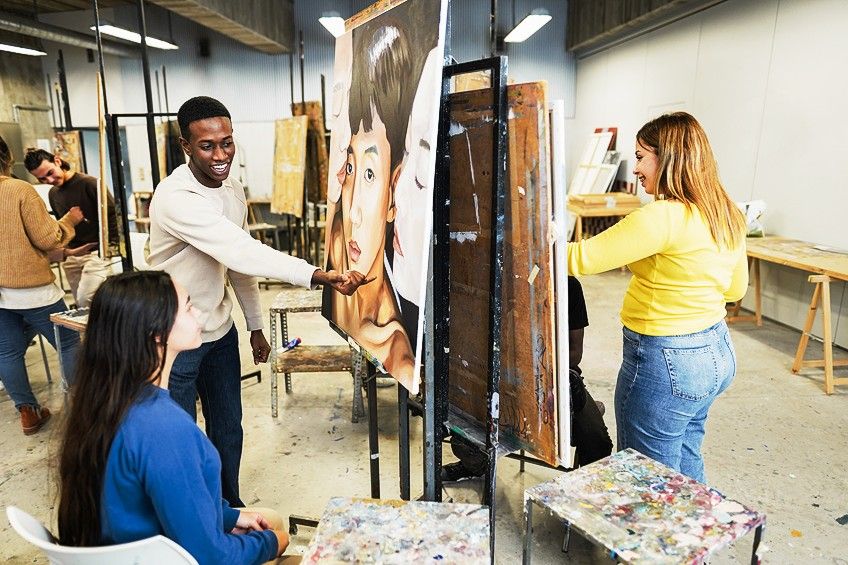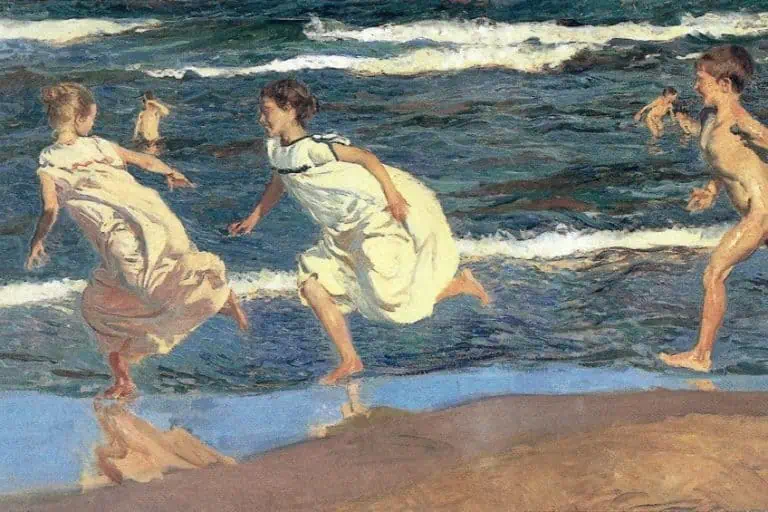Artist Residencies – A Guide to Finding Artistic Residency Programs
This post may contain affiliate links. We may earn a small commission from purchases made through them, at no additional cost to you.
Are you an artist looking for a unique experience, something that can help you develop professionally, grow your creativity, or simply learn something new? Then, you should consider artist residencies. These artistic residency programs are available locally as well as all around the world.
Table of Contents
What Is an Artist Residency?
Artist residencies are places artists can go to, where they can center their attention solely on their work. They can remove themselves from everyday life and their normal routine to focus on art. However, artistic residencies can be more than a simple retreat, and be something that helps them develop professionally and can aid in launching a new career.
Artist residencies have been around for many years and can be traced as far back as the 16th century in Europe, where art academies appear. There have been many surveys done, asking artists what their main aim is for attending an artist residency. These surveys reveal that most artists see artist residencies as a way to develop professionally, followed by it being a way to support and grow creativity. Lastly, artistic residencies, are seen as places where an artist can become part of a community of like-minded individuals.
Artistic residencies offer environments that encourage artists to focus on their work and provide artists with lodging and other proper art facilities and exposure to different worlds and cultures. Artists can connect with others from different fields of art and get to know other artists from different countries. Residency programs differ from one to another, some offer two to four-week opportunities, while others can go up to six months to an entire year.

Each art residency program can be large or small, it can be an established program, or it might be more experimental. Each program will also have its own unique environment, and some may specialize in a particular discipline, while others are open to a variety of art forms and disciplines. There are also varying lodging or housing facilities, application procedures, and financial resources.
Artistic residencies can be for most ages, but many of them are often aimed more at the younger generation of artists, to create a significant impression for future works. Artists have the opportunity to explore new locations and enjoy working with different mediums and materials. The benefits of joining artistic residency programs extend way past the residency time itself. What the artists learn, they can take with them and use the experience and knowledge gained to improve their artwork at home.
Residencies help an artist create new works, but they also help artists consider what to create, and how they will achieve this and will make them look closer at their work in a certain way. Some residencies focus more on providing a more individual approach, while others offer more of a collaborative approach.
A few artistic residencies also include visiting speakers, trips, and other events, while others are more isolated, and the artist gets to spend more time alone. So, when choosing an artistic residency, it is a lot about what you wish to get out of it. Some emerging artist residencies, for example, many of the more contemporary art residencies also focus on themes and work to pursue a certain outcome for that particular theme.
You can also find residencies that have a variety of art forms, from writers and composers to painters and photographers. So, consider who you would like to spend your time with when selecting an art residency.
What Questions to Ask When Considering an Art Residency
Since artistic residency programs are so diverse, and you are not sure of what facilities there are, you should ask some pertinent questions to make sure you know what is involved and what to expect. You need to know what is provided by the hosts and if you need to pay for anything. Here are some basic questions to consider.
- Always check to see if the residency includes accommodation and a studio, as not all of them do.
- Can you have family and friends over for visits?
- How is the accessibility, do you need to climb stairs or is there a lift, are there accessible ablution facilities and is there public transport available?
- You can ask for images of the facilities, the places where you will be living as well as working.
- Make sure to check out other basic facilities like electricity, temperature controls, running water, and lighting, is there internet, and is the workspace suitable for your needs?
- If there is a studio available, when can you access it, and does it include access on weekends and evenings?

- What kind of art residency do you want? Do you want open spaces or do you prefer to be in the city?
- Is there an admission fee and are there extra fees for things like using the internet or other facilities?
- Is there a stipend or will the artist be paid for participation?
- How long has the artist residency opportunity been active?
- Are the meals provided for the artists, do artists have to keep the accommodation clean themselves, or is this also provided?
- Are all the art materials provided or is this an extra cost?
How Are Artist Residencies Funded?
Artistic residencies can be difficult to get, so you should make the best of the opportunities that come your way. Residencies can be expensive and offer a variety of experiences, so you should choose wisely. In general, the most popular residencies are organized by various foundations, and these are often sponsored, meaning they are free. These types of residencies might even provide a small income.
However, all of this makes them more popular and so trying to get in becomes more competitive. Public funding for artists is difficult to get, as there are so many artists who apply.
Other artistic residencies are run by artists, and you are required to pay a certain fee, and the accommodation and facilities can vary considerably. This is why doing some research and asking questions is important. You might find that some residencies may even ask you to donate some of your artwork once the residency is completed. Others might ask for presentations, so make sure to get a clear picture of what is involved, both for costs and other requirements.

Whatever residency you choose, they all should have a contract agreement that includes everything that is being offered. If you cannot find one, and you still wish to apply, you can email them and ask for all the information and confirm if the email and information are correct. Make sure to agree upon any payment terms for fees or grants, and this includes any deposit required. Always have an agreement in writing, which is especially needed if applying for a residency outside the United States.
Where Do You Find Artist Residencies?
There are artistic residency programs that span all forms and fields, providing the artist with varying environments and allowing them to shape and grow their techniques. There are many artist residencies in the US, and around the world that cater to all types of artists. Many of the residencies are listed on these sites, and you can join their mailing lists to keep apprised of what residencies are available Globally and in the United States.

In the United States, you have a wide variety of established and emerging artist residencies from those that cater to artists who enjoy outdoor spaces like the Grand Canyon to well-known locations like the Woodstock Guild in New York, where Bob Dylan was a participant.
- Residency Opportunities by the Pennsylvania Academy of the Fine Arts
- Listed and shared Document of artist opportunities by Everest Pipkin
How to Apply for Artist Residencies
The various criteria and funding for art residencies vary greatly among programs. When it comes to applying to artistic residencies, applications usually involve submitting project proposals, resumes, a letter of motivation, and other documentation. Some programs are designed for specific works and may have some restrictions, while others give artists free rein to do what they want.
Before applying, an artist should ask themselves why they want to participate in a residency.
This can help to specify your area of work and can help to narrow down your choices when searching for a residency. For instance, you can look for a residency that focuses on landscapes in the United States. So, when it comes to artist residencies in the US, you might want to include the National Parks system.
If you have a family and regular work, the residency should be able to fit around these other responsibilities. Think about the environment you like working in or want to try out. Do you work best in the country or an urban location, for instance?
Once you have decided on what and where you might want to do more research into the program and where it is situated. Look for reviews and check what other artists are saying about what they have experienced.
Many of the artistic residencies have requirements that you need to follow. For example, they may require you to exhibit your work at the end of your time there, which might require collaboration with other artists, you might have to teach or provide community workshops, or there is a specific theme involved. However, other programs offer you freedom of work and time, and there is no obligation towards the host. Although often there is some form of conditions that must be met.

Many residency opportunities offer application guidelines, which include documentation such as a resume or curriculum vitae and a letter of motivation, however, each program can have its own set of rules and requirements. Many of the programs are planned ahead of time, so consider this when planning a residency.
The application can take time and perseverance, so take time to check the information required. Once you have the information, you can then formulate your letter of motivation, which should align with the particular program. The choice you make should match your needs and expectations. The proposal should also be authentic, and applicable to the program you want to join. So, you can use some information to send out to multiple programs, but make sure to change the proposal to fit the criteria of the specific residency.
Unless you are a well-known and popular artist, the chance of rejection is quite possible. The answer, keep applying. Some artists apply to hundreds of artistic residency opportunities. Many of the residencies have an application fee, so read the requirements, and if you are not eligible, do not even bother to apply, you will just be wasting your money.
However, those programs that have a fee, are mostly less competitive. Try a few of these that you are eligible for, build up a resume, and then go for the more prestigious organizations that only take a few artists each time. Remember to do your research and identify an organization’s guidelines before applying. Gaining experience in a specific residency can also advance a professional reputation.
Also, any professional as well as personal relationships formed during the residency are important and can open doors to new opportunities.
Tips for Having the Best Artist Residency Experience
There are many practical tips and advice you can follow to help you have the best art residency experience. Of course, some artists have a lot of experience, and reading up on some artists who write about their experiences is a good idea. If you have other personal and financial responsibilities, consider a shorter residency that will not take up too much time or money.
Consider keeping notes or a diary of your experiences. This way you can work out the best working conditions and then try to recreate the same when you return home. When at a residency, do not be afraid to ask questions, if you do not understand something, or something is not working as it should, the staff is there to help.
As important as it is to work on your art and get it done, it is also good to take your time and enjoy the moment. Doing this may even help you to improve your creativity. Explore the surrounding area and enjoy what there is on offer.

Artistic residencies are mainly there for exploring and making art, but it is also something to help improve your chances at career advancement. However, you should not expect to get a gallery exhibition offer as soon as the residency ends. Focus more on the creative process, forming connections, and becoming part of a supportive community of creatives. Here are a few more recommended tips and ideas.
- Apply to as many residencies as you can during the year, and if rejected try again. Some artists have only gotten accepted after trying a few times.
- Many times, approval relies on a strong portfolio, this means that whatever stage you are, whether just starting or a seasoned artist, you can apply.
- You might think it is about creating more art pieces but you should not feel pressure to do a whole lot of new work. It is about how you grow in your art and not how productive you can be.
- Learn all about the program and what is on offer before applying.
- Make goals but do not plan ahead too much, as you might find you have to adapt and try new things.
- Socialize and have fun, which could lead to great friendships and other opportunities.
So, if you are an artist who loves to try new things and you also like to travel, then applying to various artistic residency programs should be on your list of things to do. This type of artistic adventure should not be missed!
Frequently Asked Questions
What Is an Artist Residency?
Artist residencies provide new and exciting environments for an artist to work in. These types of residencies provide a space away from the normal day-to-day routine, where artists can focus on growing and developing their talent.
How Are Artist Residencies Funded?
Various foundations usually provide free residencies, and sometimes also come with a small stipend. However, these are quite difficult to get in as you have quite a bit of competition. Other residencies can be run by artists, who then require a fee for the accommodation and other materials.
How Do You Apply for Artist Residencies?
First, you need to find out what residency is right for you, then do some research, and always read the requirements and application thoroughly. You can then gather your information, motivation letter, proposal, and resumé. Make sure it is a tailored application for the specific residency. Review and get feedback, and then submit your application.
Should You Document the Artwork Done at a Residency?
Yes, it is important to document and share the work you have done. You can do this by writing about your experiences, taking photos and videos, and creating a blog where you can introduce your projects.
In 2005, Charlene completed her wellness degrees in therapeutic aromatherapy and reflexology at the International School of Reflexology and Meridian Therapy. She worked for a company offering corporate wellness programs for several years before opening her own therapy practice. In 2015, she was asked by a digital marketer friend to join her company as a content creator, and it was here that she discovered her enthusiasm for writing. Since entering the world of content creation, she has gained a lot of experience over the years writing about various topics such as beauty, health, wellness, travel, crafting, and much more. Due to various circumstances, she had to give up her therapy practice and now works as a freelance writer. Since she is a very creative person and as a balance to writing likes to be active in various areas of art and crafts, the activity at acrylgiessen.com is perfect for her to contribute their knowledge and experience in various creative topics.
Learn more about Charlene Lewis and about us.







